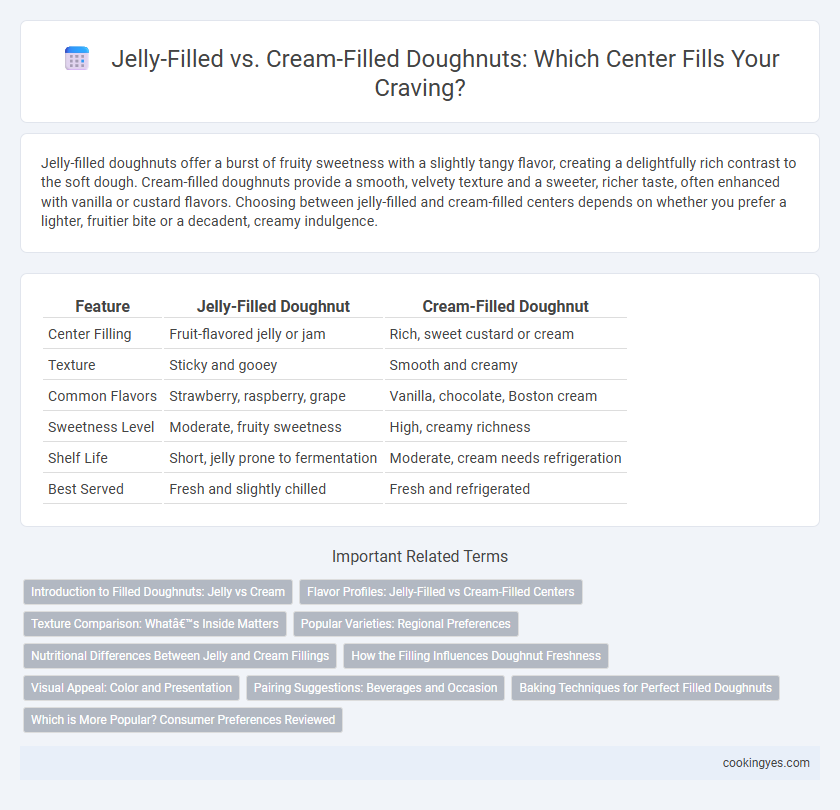Jelly-filled doughnuts offer a burst of fruity sweetness with a slightly tangy flavor, creating a delightfully rich contrast to the soft dough. Cream-filled doughnuts provide a smooth, velvety texture and a sweeter, richer taste, often enhanced with vanilla or custard flavors. Choosing between jelly-filled and cream-filled centers depends on whether you prefer a lighter, fruitier bite or a decadent, creamy indulgence.
Table of Comparison
| Feature | Jelly-Filled Doughnut | Cream-Filled Doughnut |
|---|---|---|
| Center Filling | Fruit-flavored jelly or jam | Rich, sweet custard or cream |
| Texture | Sticky and gooey | Smooth and creamy |
| Common Flavors | Strawberry, raspberry, grape | Vanilla, chocolate, Boston cream |
| Sweetness Level | Moderate, fruity sweetness | High, creamy richness |
| Shelf Life | Short, jelly prone to fermentation | Moderate, cream needs refrigeration |
| Best Served | Fresh and slightly chilled | Fresh and refrigerated |
Introduction to Filled Doughnuts: Jelly vs Cream
Jelly-filled doughnuts feature a vibrant, fruity center typically made from strawberry, raspberry, or grape preserves that deliver a tangy contrast to the sweet dough. Cream-filled doughnuts, often filled with custard or Bavarian cream, offer a rich, velvety texture and a smooth, sweet flavor profile. Both types of filled doughnuts provide unique taste experiences, making them popular choices in bakery selections worldwide.
Flavor Profiles: Jelly-Filled vs Cream-Filled Centers
Jelly-filled doughnuts offer a tangy and fruity flavor profile, providing bursts of sweetness and slight tartness that balance the dough's richness. Cream-filled centers deliver a smooth, velvety texture with a rich, sweet taste often enhanced by vanilla or custard notes, creating a decadent indulgence. Comparing the two, jelly-filled doughnuts emphasize bright, refreshing flavors, while cream-filled varieties highlight creamy, dessert-like richness.
Texture Comparison: What’s Inside Matters
Jelly-filled doughnuts boast a smooth, fruity center that offers a slightly sticky, yet tender texture contrasting the soft, airy dough, while cream-filled varieties provide a rich, velvety interior that melts seamlessly with each bite. The gelatinous consistency of the jelly creates a gentle tension against the dough, enhancing the chewiness, whereas the creamy filling contributes to a luxurious mouthfeel with a denser, silky finish. Texture differences between jelly and cream centers greatly influence the overall eating experience, making the choice a key factor for doughnut enthusiasts seeking specific sensory satisfaction.
Popular Varieties: Regional Preferences
Jelly-filled doughnuts are favored in regions like the Northeastern United States, where tart fruit flavors such as raspberry and strawberry are popular choices. Cream-filled doughnuts dominate in the Midwest, featuring varieties like Bavarian cream and vanilla custard that appeal to preferences for rich, smooth textures. Regional bakeries often highlight these differences, tailoring flavors to local tastes and creating distinct regional doughnut identities.
Nutritional Differences Between Jelly and Cream Fillings
Jelly-filled doughnuts typically contain fewer calories and less fat than cream-filled varieties due to their fruit-based fillings, which are often lower in saturated fat and cholesterol. Cream-filled doughnuts use custard or whipped cream, contributing higher amounts of saturated fat, cholesterol, and added sugars, impacting overall calorie content and heart health considerations. Choosing between jelly and cream fillings can significantly affect nutritional intake, particularly regarding sugar levels, fat content, and calorie density.
How the Filling Influences Doughnut Freshness
Jelly-filled doughnuts often retain moisture longer due to the thick, sugar-rich jelly that acts as a natural barrier against staleness, preserving softness. Cream-filled doughnuts, with their dairy-based centers, are more prone to spoilage and require refrigeration to maintain freshness, impacting shelf life negatively. The type of filling directly affects doughnut texture and freshness duration, making jelly fillings preferable for longer-lasting treats.
Visual Appeal: Color and Presentation
Jelly-filled doughnuts offer vibrant, translucent centers in shades of red, purple, or orange, creating striking visual contrast against the golden-brown dough. Cream-filled doughnuts typically display pale, creamy hues that complement the dough's neutral tone, providing a subtle and smooth presentation. The choice between jelly and cream fillings significantly influences the doughnut's color dynamics, enhancing either vivid or classic aesthetic appeal.
Pairing Suggestions: Beverages and Occasion
Jelly-filled doughnuts pair excellently with light teas or sparkling lemonade, complementing their fruity sweetness and making them ideal for casual afternoon gatherings or brunch events. Cream-filled doughnuts, rich and indulgent, are best enjoyed with bold coffee or a dessert wine, perfect for cozy coffee dates or elegant evening occasions. Selecting the right beverage enhances the doughnut experience by balancing flavors and suit the event ambiance.
Baking Techniques for Perfect Filled Doughnuts
Jelly-filled doughnuts require precise injection techniques to evenly distribute the filling without breaking the dough, often using piping bags with narrow nozzles for controlled application. Cream-filled doughnuts depend on stable, chilled custards or whipped fillings that maintain consistency during frying and cooling, ensuring the doughnut's structure remains intact. Optimal proofing and frying temperatures are crucial for both types to achieve a golden crust while preserving the delicate center filling.
Which is More Popular? Consumer Preferences Reviewed
Jelly-filled doughnuts often edge out cream-filled varieties in popularity due to their fruity sweetness and vibrant flavors, appealing especially to consumers seeking a lighter, tangier center. Cream-filled doughnuts attract those who prefer a rich, velvety texture paired with flavors like vanilla, chocolate, or custard, making them a staple in many bakeries. Market surveys and consumer preference studies consistently show a slight preference for jelly-filled options, although regional tastes can significantly influence this trend.
Jelly-filled vs Cream-filled for center Infographic

 cookingyes.com
cookingyes.com